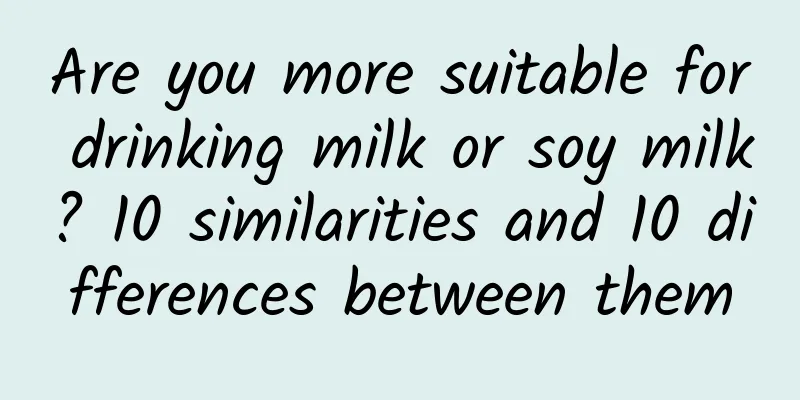Are you more suitable for drinking milk or soy milk? 10 similarities and 10 differences between them

|
The Chinese Dietary Guidelines 2022 recommends drinking 300-500 ml of milk every day, and consuming soy products, including soy milk, equivalent to 25 grams of soybeans. 1 cup (250 grams) of traditional soy milk is equivalent to about 12.5 grams of soybeans (1 portion of soybeans + 20 times the amount of water to make soy milk, not too thick). However, many people are confused. Their appetite for breakfast is so big. It would be great to have a cup of soy milk and milk, but I really can't drink it... Besides, both drinks have their supporters and opponents. People who support milk say: Milk is more nutritious than soy milk! Milk can supplement calcium, but soy milk cannot! People who support soy milk say: Soy milk is more suitable for Chinese people's stomach than milk! Soy milk is good for preventing diseases, but milk is useless! Some people say: Soy milk is not suitable for people with breast diseases! Others argue that milk is not good for preventing breast cancer! I guess many people feel dizzy after hearing these words and don’t know what to choose. In fact, this may be due to insufficient understanding of milk and soy milk. Are you more suitable for drinking soy milk or milk? Knowing the difference between them will help you know which one to choose. This is probably the most comprehensive description ever of the properties of soy milk and cow's milk that you will ever find. Let’s first talk about what they have in common. There are actually more similarities between milk and soy milk than many people imagine. ——Both milk and soy milk provide protein. The protein content in milk is 2.9%~3.6%, roughly 3%; the protein content in soy milk depends on how much beans and water are added, ranging from 1.8% to 3.6%. You should carefully check the protein content on the food label. Of course, if concentrated, both can produce higher protein content. ——Both milk and soy milk provide fat. The fat in milk is cream, and the fat in soy milk is soybean oil. After these fats are emulsified by proteins and phospholipids, they form tiny fat microspheres, which are suspended in the water phase and scatter light. As a result, they look like milky white liquid. ——Both milk and soy milk provide a lot of potassium. Don't think that milk only has calcium but no potassium. In fact, the potassium content is higher than the calcium content! Beans are classic high-potassium foods, so soy milk also has a lot of potassium. According to the data of the "Chinese Food Composition Table (Standard Edition)", 100 grams of soy milk with a protein content of 3.0% contains 117 mg of potassium, while 100 grams of milk with a protein content of 3.3% contains 188 mg of potassium. Therefore, for patients with hypertension, both are good drinks. ——Both milk and soy milk contain a variety of B vitamins, vitamin E and vitamin K. Whole milk contains vitamin E and vitamin K, while skim milk contains very little. But skim milk still contains 8 B vitamins. Soy milk inherits the advantages of soybeans being rich in vitamin E and vitamin K, and also incorporates 7 B vitamins found in soybeans. ——Both milk and soy milk can give you a good feeling of fullness. The protein and fat in milk and soy milk can promote gastrointestinal hormones such as cholecystokinin, GIP and GLP-1 to increase the feeling of fullness. Although they are ingested in liquid form, they will turn into clots under the action of gastric acid after entering the stomach. The gastric emptying time is much longer than that of white porridge and sweet drinks with the same calorie value, so the satiety effect is more lasting. ——Drinking milk and soy milk can help suppress the rise of blood sugar after a meal. Literature has found that drinking milk or soy milk while eating white bread can reduce the blood sugar response after a meal. However, if you drink milk or soy milk 30 minutes before a meal and then eat bread, the effect will be more significant. When the protein content is the same, the blood sugar control effect of milk and soy milk is not much different. ——Both milk and soy milk are low-glycemic index beverages, but both stimulate insulin production. Many people have heard that although milk has a low glycemic index, it has a high insulin index. In fact, almost all high-protein foods can stimulate insulin by increasing gastrointestinal hormones GIP and GLP-1, and this is not exclusive to milk. Soy milk is also a source of protein, and soy protein also has this effect. ——Both milk and soy milk promote muscle growth. Whey protein and casein in milk, as well as soy protein in soy milk, can promote muscle growth. Drinking a glass of milk or soy milk immediately after exercise is beneficial to muscle synthesis. In terms of effect, milk protein is slightly better because it is rich in leucine, but a study compared the two and found that the muscle growth effect of whey protein and soy protein is only 20% different. ——Both milk and soy milk can easily cause bloating, and the principles of bloating are similar. The reason why milk causes bloating is the lactose in it. People with insufficient lactase secretion cannot fully digest it. The undigested lactose enters the large intestine and can cause intestinal gas production, intestinal rumbling, abdominal bloating, diarrhea and other problems. The reason why soy milk causes bloating is the oligosaccharides it contains, including raffinose, stachyose, verbascose, etc., which cannot be digested and absorbed by the human small intestine and will cause discomfort after entering the large intestine. However, for people with normal digestive ability, when consumed in small amounts, lactose and these oligosaccharides are factors that promote the proliferation of beneficial intestinal bacteria, and are also beneficial to the absorption and utilization of various minerals in food. ——Both milk and soy milk can help replenish water. Although milk and soy milk contain a variety of solutes, their water content is as high as 87% or more. Pure water will be absorbed and utilized within about 20 minutes, but water with solutes is absorbed more slowly in the body. As the nutrients in milk and soy milk are gradually absorbed and utilized, water is slowly absorbed and utilized. Studies have found that compared with drinking the same amount of water, drinking milk keeps water in the body longer. Of course, this is for unsweetened milk and soy milk. Adding sugar will increase the osmotic pressure and reduce their hydrating effect. Let’s talk about their differences. ——There are vitamins AD and B12 in milk, but not in soy milk. This is because plant-based foods do not contain these vitamins. There is a small amount of carotene in soy milk, but it is still too little to be converted into vitamin A. ——There is a lot of calcium in milk, but very little in soy milk. Milk is the most easily available natural food for calcium, with more than 100 mg of calcium in every 100 grams of milk. Although there is a lot of calcium in soybeans, the content drops significantly after dilution with water. If the calcium content in 100 grams of soybeans is 200 mg, according to the traditional soy milk, 1 catties of soybeans plus 20 catties of water, the calcium content in every 100 grams of soy milk is about 10 mg. If it is made into thick soy milk, it is about 20 mg. The calcium content of some soy milks is only a few mg/100 grams. Therefore, soy milk cannot replace the calcium supplementation effect of milk, and other plant milks cannot either, unless a lot of easily absorbed calcium is added. ——The proportion of saturated fat in milk is relatively high, while that in soy milk is very low. The fat in milk is cream, which contains about 40% to 50% saturated fat, and the rest is mostly monounsaturated fatty acids (the fatty acid that is most abundant in olive oil). The fat in soy milk is soybean oil, of which more than 80% is unsaturated fatty acids, and saturated fatty acids account for only a dozen percent. Therefore, if you follow the doctor's advice to control saturated fatty acids, you can choose low-fat milk or skim milk, or soy milk. ——Soy milk contains oligosaccharides and dietary fiber, but milk does not. Dietary fiber is only found in plant foods (except for shrimp and crab shells). There are also oligosaccharides in milk, but the content in milk is relatively low and not enough to produce effective health effects. Breast milk contains relatively rich breast milk oligosaccharides, which are an important part of the health effects of breast milk and are extremely beneficial to the intestinal health of infants. Too much oligosaccharide in soy milk will cause flatulence, but when consumed in small amounts, it is beneficial to the intestinal health of most people. ——There are many anti-nutrients in soy milk, which are not found in milk. Soy milk contains anti-nutrients such as trypsin inhibitors, lectins, phytic acid, oxalic acid, saponins, etc., which can reduce the absorption and utilization efficiency of protein and various minerals. Among them, phytic acid, oxalic acid and saponins are still retained after heating, but because some of them will combine with proteins, polysaccharides and other ingredients, their biological effects on digestion and absorption are reduced. Lectins and trypsin inhibitors are mostly destroyed after heating. According to our actual measurements and relevant literature data from Japan, Commercially available soy milk and soy milk made from household soy milk machines still have about 13% of the trypsin inhibitor activity remaining. Prolonging the heating time can further destroy the trypsin inhibitor, but it contains heat-resistant components, and even after long-term heating, about 5% of the activity will still remain. Trypsin inhibitor is an ingredient that can inhibit the proliferation of cancer cells. For healthy people, a small amount of residual activity is beneficial to health rather than harmful. ——Soybean milk contains soy isoflavones, but milk does not. Everyone knows that soy isoflavones in soy milk are a type of phytoestrogen. In the case of estrogen deficiency during menopause, supplementing phytoestrogen can help alleviate the discomfort of menopausal syndrome and prevent osteoporosis in middle-aged and elderly women. For men, epidemiological studies have found that consuming soy isoflavones can help prevent prostate cancer in men. There is currently no evidence that Asian women who consume normal amounts of soy milk and soy products will increase their risk of breast cancer. ——Some people get acne on their faces after drinking milk, but soy milk doesn’t. Ingredients such as IGF-1 in milk promote sebum secretion, increasing the risk of acne worsening. In this regard, switching to skim milk or lactose-free milk is no better than regular whole milk. Soy milk does not promote sebum secretion. ——For some people, drinking soy milk will affect the menstrual cycle or premenstrual feeling, but milk will not. For women of childbearing age who have never drunk soy milk before, the phytoestrogens in soy milk may temporarily affect the menstrual cycle after suddenly drinking more soy milk every day, but after the new cycle is formed, it will not affect health. The reaction to soy milk varies from person to person. People who have often eaten soy products since childhood have little reaction, while people who have rarely been exposed to soy products before may be more sensitive. ——For people with high uric acid, drinking milk can help reduce uric acid and prevent gout, but soy milk cannot. Milk is a food with extremely low purine content, and its potassium, calcium, orotic acid and other ingredients are all beneficial to lowering uric acid levels. Therefore, gout patients are suitable to drink milk every day during both the attack and remission periods. Soybeans are a medium-high purine food. Although the content decreases after being made into soy milk, the total amount of purine cannot be ignored because soy milk is drunk in one cup or bowl. At the same time, ingredients such as phytic acid and oxalic acid in soy milk will also affect the excretion of uric acid. Some scholars in my country have conducted experiments and found that drinking soy milk will cause a temporary increase in blood uric acid levels, but it will return to normal after 3 to 4 hours. Epidemiological surveys show that healthy people who normally consume soy milk and soy products will not increase the risk of uric acid, but people who already have gout or hyperuricemia are not recommended to drink large amounts of soy milk. ——Different groups of people are allergic to milk and soy. Both milk and soy are common food allergens. People who are acutely allergic to milk are usually infants under 2 years old, and less so in adults. But after adulthood, people with chronic allergies to milk are still common. Adults who are allergic to soy are not uncommon. Going to the allergy department of a tertiary hospital to request a food allergy or intolerance test can often reveal these problems. Doing food elimination experiments one by one can also find out the chronic food allergens that cause you various discomforts. However, some people are only allergic to milk, or only to soy. For example, I had a test 3 years ago, and the results showed that I had no allergies to milk at the time, but I had a grade 3 chronic allergy to soy (including yellow soybeans, black soybeans, and green soybeans). How about it? After reading this, most of you may have come to your own conclusion about whether it is more suitable to drink milk or soy milk, or drink both. Finally, let’s summarize: Soy milk and milk are both drinks with good nutritional value. If there are no adverse reactions, it is worth drinking them regularly. Most people are suitable for both. A glass of milk in the morning and a glass of soy milk in the evening, or a glass of soy milk in the morning and a glass of milk in the evening, according to your wishes. For people who need to control blood sugar, drinking a glass of milk or soy milk before or before eating starchy foods can help control postprandial blood sugar response. People who want to lose weight can use milk or soy milk to replace sweet drinks and cold drinks, which not only increases nutrition but also helps prevent obesity. Under the same protein content, milk is more recommended, because obesity is more likely to occur when calcium is deficient, and it is also easy to lack multiple vitamins when losing weight. Pregnant women and breastfeeding mothers can drink both, but milk is more important because it can supplement the large amount of calcium needed during pregnancy and breastfeeding. Menopausal women can drink both, milk increases calcium intake, and soy milk increases the supply of soy isoflavones. The combination is more beneficial to bone health. A few people need to choose one. For example, people who are prone to acne after drinking milk can drink soy milk as a substitute, and at the same time they can take a calcium tablet containing 200~300 mg of calcium. For example, gout patients are more suitable to drink milk, especially during the gout attack period. Fish, meat, seafood, river food, soy milk, and tofu are not suitable for eating for the time being, but you can safely drink two or three cups of skim milk to help supply high-quality protein, calcium and water. For some people, neither may be suitable. For example, people who are allergic to both milk and soy should not drink either. Some patients with thyroid disease and irritable bowel syndrome can also temporarily avoid milk and soy foods if they are advised by their doctor. In addition, people with poor digestion and bloating should also drink less, after all, both contain ingredients that may cause bloating. However, this does not prevent you from enjoying the nutrition of milk and soybeans, because you can drink yogurt and eat cheese instead of milk, or eat tofu and dried tofu instead of soy milk. Eating small amounts and multiple times will not easily cause discomfort. Some people have no physiological taboos on milk or soy milk, but just don't like the flavor of one of them. Here is a suggestion: have you tried mixing milk and soy milk? It not only dilutes the bean flavor of soy milk, but also covers up the mutton smell of milk. The flavor is better and worth tasting! If you add a little bit of honey and salt, it can replenish energy, protein and water at the same time. It can replace various sweet drinks and sports drinks after exercise in summer. It is very good for restoring physical energy and increasing muscle. Reprint/ Cooperation please contact Weibo/ Official Account: Fan Zhihong_Original Nutrition Information Toutiao contracted author Post-scientist at Beijing Food Nutrition and Human Health Advanced Innovation Center Director of Chinese Nutrition Society Director of China Health Promotion and Health Education Association China Association for Science and Technology appoints chief expert on nutrition science communication PhD in Food Science, China Agricultural University |
>>: About 200,000 species have become extinct. Is the sixth mass extinction about to begin?
Recommend
Tips for setting up a Toutiao advertising promotion account!
The information flow of Toutiao is becoming more ...
Eating this dish for a week can cause gastrointestinal bleeding! This springtime delicacy is delicious, but these types of people should be careful
Speaking of spring, it always makes people happy....
Kugou Music product analysis!
During the iterative optimization process, produc...
NetEase’s marketing methodology for screen-sweeping!
To swipe the screen once may be luck, but to swip...
The truth is out! How big is the gap between iOS and Android?
Today, Android, which was once criticized by peop...
iOS 15 update failure: Cannot use Siri to adjust AirPods Pro active noise reduction/transparency mode
MacRumors quoted many netizens as saying that App...
Allergies are prevalent in autumn, what should we do?
《Cotton Swab Medical Science Popularization》 Wei ...
All of them are "big oil absorbers"! These 5 types of vegetarian food can make you grow fatter than meat dishes
This article was reviewed by Zhang Zhaomin, Maste...
7 successful startups teach you how to use social media for marketing!
Written by: Sujan Patel With over 12 years of dig...
LeTV plans to raise another 4.5 billion yuan to fill the biggest shortcoming of LeTV ecosystem
Due to the rapid development of terminal and othe...
Samsung Galaxy S6 battery leak: capacity decreases instead of increases
Samsung's next flagship Galaxy S6 may have a ...
Super powerful German Apollo intends to develop a 1,000-horsepower electric supercar
Last March, German car brand Apollo unveiled the ...
Be careful of waist aging before aging! These postures are the most harmful to waist...
Sitting for a long day at work and lying down lik...









